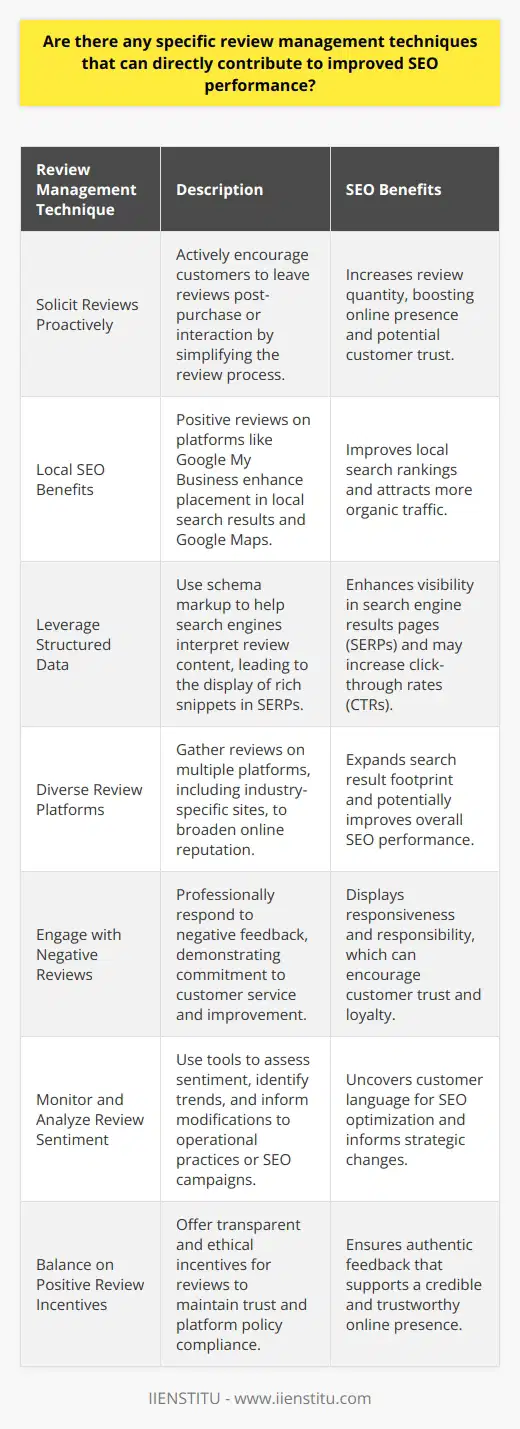
Introduction
As a small business owner, I've always been fascinated by the intricacies of search engine optimization (SEO). I remember the early days of my entrepreneurial journey, huddled over my laptop, trying to decipher the secrets of Google's algorithm. I spent countless hours researching keywords, optimizing meta tags, and restructuring my website's content, all in the hopes of improving my search rankings and driving more traffic to my site.
But despite my best efforts, something wasn't clicking. My traffic numbers remained stagnant, and I couldn't quite put my finger on what I was missing. It wasn't until I had a serendipitous conversation with a customer that everything changed.
I was at a local networking event, chatting with a woman who had recently purchased one of my products. As we discussed her experience, she mentioned that she had found my website by searching for a specific phrase – one that I hadn't even considered targeting. That's when it hit me: I had been so focused on what I thought my customers were searching for that I had neglected to actually ask them.
Introduction
Gaining Customer Feedback
Benefits of Customer Feedback
Uncovering SEO Secrets
Conclusion
That conversation was a turning point for me. I realized that if I truly wanted to optimize my website for search engines, I needed to start by optimizing it for my customers. I needed to understand their needs, their pain points, and the language they used when searching for products or services like mine.
And so began my journey into the world of customer feedback and SEO. Over the years, I've learned that these two concepts are inextricably linked – that by gathering and analyzing customer feedback, we can uncover valuable insights that inform and enhance our SEO strategies.
In this article, I'll share some of the key lessons I've learned about leveraging customer feedback for SEO success. We'll explore the benefits of gathering customer feedback, the most effective techniques for collecting it, and how to analyze and implement that feedback into your SEO efforts. Along the way, I'll share some real-life examples and case studies that illustrate the power of this approach.
Whether you're a seasoned SEO professional or a small business owner just starting to dip your toes into the world of search optimization, I hope that this article will provide you with actionable insights and inspiration to start leveraging customer feedback in your own SEO journey.
The Benefits of Customer Feedback for SEO
Before we dive into the specifics of gathering and analyzing customer feedback, let's take a moment to explore why this approach is so valuable for SEO.
1- Uncover Long-Tail Keywords
One of the primary benefits of customer feedback is that it can help you uncover long-tail keywords that you may not have considered targeting. Long-tail keywords are longer, more specific phrases that customers use when searching for products or services online. For example, instead of searching for "running shoes," a customer might search for "best running shoes for flat feet."
The key to unlocking SEO success lies in listening to your customers.
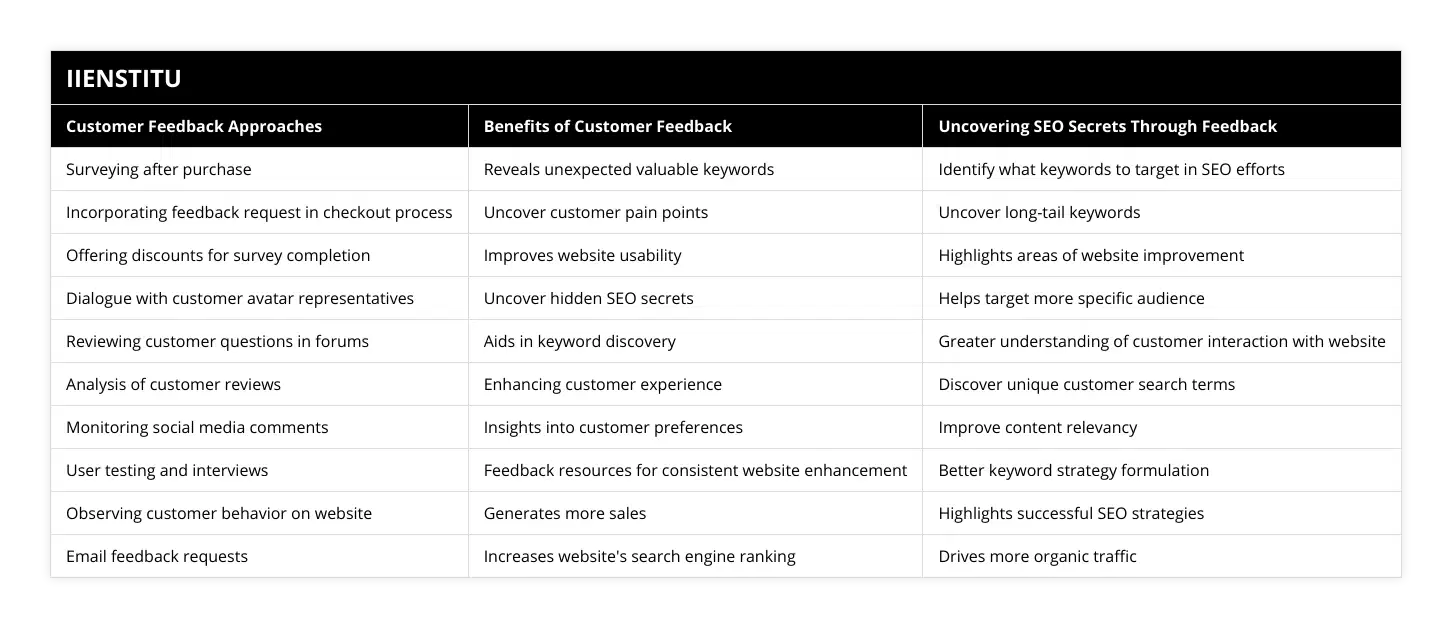
These longer, more specific phrases often have less competition than broad, generic keywords, making them easier to rank for. And because they're more targeted, they tend to attract customers who are further along in the buying process and more likely to convert.
By gathering customer feedback, you can gain insight into the specific language and phrases that your customers use when searching for your products or services. You might discover that they use industry jargon, colloquialisms, or even misspellings that you hadn't considered. By incorporating these terms into your website's content and metadata, you can improve your chances of ranking for these valuable long-tail keywords.
2- Improve User Experience
Another key benefit of customer feedback is that it can help you improve your website's user experience. Your customers are the ones who are actually navigating your site, and their feedback can provide valuable insights into what's working well and what could be improved.
For example, you might discover that customers are having trouble finding a specific product or piece of information on your site. By making changes to your site's navigation or layout based on this feedback, you can make it easier for customers to find what they're looking for, reducing bounce rates and increasing engagement.
Or perhaps you'll learn that customers are frustrated by slow page load times or a clunky checkout process. By addressing these technical issues, you can improve the overall user experience and reduce the likelihood of customers abandoning your site in frustration.
3- Build Trust and Authority
Gathering and responding to customer feedback can also help build trust and authority with your audience. When customers feel heard and valued, they're more likely to view your brand positively and recommend it to others.
By actively seeking out feedback and making changes based on that feedback, you demonstrate that you're committed to meeting your customers' needs and providing the best possible experience. This can help establish your brand as a trusted authority in your industry, which can in turn improve your search rankings.
As Google's algorithms have become more sophisticated, they've started to place greater emphasis on factors like user engagement, brand mentions, and customer reviews. By building a strong reputation through customer feedback, you can send positive signals to search engines and improve your chances of ranking well.
4- Inform Content Strategy
Customer feedback can also provide valuable insights to inform your content strategy. By understanding what questions your customers are asking, what topics they're interested in, and what challenges they're facing, you can create content that directly addresses their needs and interests.
For example, if you notice that many customers are asking about a specific product feature or use case, you might create a blog post or video that provides an in-depth explanation or demonstration. Or if you discover that customers are seeking advice on a particular topic related to your industry, you could create an informative guide or eBook that positions your brand as a helpful resource.
By creating content that is directly informed by customer feedback, you can improve its relevance and value to your audience. This can help attract more traffic to your site, keep visitors engaged for longer periods of time, and ultimately improve your search rankings.
Now that we've explored some of the key benefits of leveraging customer feedback for SEO, let's take a look at some of the most effective techniques for gathering that feedback.
Techniques for Gathering Customer Feedback
There are many different ways to gather customer feedback, each with its own strengths and weaknesses. The key is to use a combination of techniques to get a well-rounded picture of your customers' needs, preferences, and experiences.
1- Surveys
One of the most common and effective ways to gather customer feedback is through surveys. You can use tools like Google Forms, SurveyMonkey, or Typeform to create simple surveys that ask customers about their experience with your brand, products, or website.
When creating a survey, it's important to keep it short and focused. Aim for no more than 10-15 questions, and make sure each question is clear and unambiguous. You might ask customers about their overall satisfaction with your products or services, what they like or dislike about your website, or what features or improvements they'd like to see in the future.
To encourage participation, consider offering an incentive like a discount code or entry into a prize drawing for completing the survey. You can also experiment with different delivery methods, such as embedding the survey on your website, sending it via email, or even promoting it on social media.
2- Customer Interviews
While surveys are great for gathering broad, quantitative data, customer interviews can provide more in-depth, qualitative insights. By having one-on-one conversations with customers, you can ask follow-up questions, probe for more details, and get a deeper understanding of their needs and experiences.
When conducting customer interviews, it's important to have a clear agenda and set of questions prepared in advance. You might ask customers about their decision-making process when choosing your product or service, what challenges they were trying to solve, or how they feel about specific features or aspects of your offering.
To get the most out of customer interviews, try to create a comfortable, conversational atmosphere. Avoid yes/no questions or leading questions that might bias the response. And be sure to listen actively and take detailed notes (or even record the conversation with the customer's permission).
3- Social Media Monitoring
Social media platforms like Twitter, Facebook, and Instagram can be a goldmine of customer feedback. By monitoring mentions of your brand or products on these platforms, you can gain insight into what customers are saying about you – both good and bad.
There are many tools available to help with social media monitoring, such as Hootsuite, Sprout Social, or Mention. These tools allow you to track mentions of your brand across multiple platforms, respond to customer inquiries or complaints, and even analyze sentiment over time.
In addition to monitoring your own brand mentions, it can also be helpful to track conversations around your industry or niche more broadly. This can help you identify trends, pain points, or opportunities that you may not have considered before.
4- On-Site Feedback
Another valuable source of customer feedback is the feedback you receive directly on your website. This might include comments on blog posts, reviews of products or services, or even feedback submitted through a contact form.
To encourage on-site feedback, make sure you have clear calls-to-action throughout your site inviting customers to share their thoughts. You might include a prominent "Leave a Review" button on product pages, or a "Contact Us" form that is easy to find and use.
It's also important to respond to any feedback you receive in a timely and professional manner. Thank customers for their input, address any concerns or complaints, and let them know how you plan to use their feedback to improve your offerings.
5- User Testing
Finally, user testing can be a powerful way to gather feedback on specific aspects of your website or product. User testing involves recruiting a small group of representative customers and observing them as they interact with your site or product.
During a user testing session, you might ask participants to complete specific tasks (like finding a particular product or piece of information), and observe how they navigate your site and what challenges they encounter. You can also ask for their feedback on specific features, designs, or messaging.
User testing can be conducted in person or remotely using tools like UserTesting or UsabilityHub. The key is to create a structured test plan with clear objectives and tasks, and to gather both quantitative data (like task completion rates) and qualitative feedback (like participant comments and observations).
By using a combination of these feedback gathering techniques, you can develop a comprehensive understanding of your customers' needs, preferences, and experiences. But gathering feedback is only the first step – the real magic happens when you start analyzing and implementing that feedback into your SEO strategy.
Analyzing and Implementing Customer Feedback
Once you've gathered a wealth of customer feedback, the next step is to analyze that feedback and identify actionable insights that can inform your SEO efforts. Here are some key steps to follow:
1- Categorize Feedback
Start by organizing your feedback into categories based on common themes or topics. This might include categories like website usability, product features, customer service, or content topics.
By categorizing your feedback, you can start to identify patterns and trends that may not have been apparent when looking at individual responses. For example, you might notice that a significant number of customers are mentioning a specific pain point or challenge that you hadn't previously considered.
2- Identify Opportunities for Improvement
Next, look for opportunities to improve your website or offerings based on the feedback you've received. This might include making changes to your site's navigation or layout, adding new features or content, or even developing entirely new products or services.
Be sure to prioritize your improvements based on the impact they're likely to have on your customers and your business. Focus on changes that will address the most common or pressing issues first, and then work your way down the list.
3- Update Your Keyword Strategy
One of the most valuable things you can do with customer feedback is to use it to inform your keyword strategy. Look for common phrases or terms that customers use when describing your products, services, or industry, and consider incorporating those terms into your website's content and metadata.
For example, if you notice that many customers are using a specific phrase to describe your product (like "eco-friendly cleaning solution"), you might optimize your product pages or blog content around that phrase to improve your chances of ranking for those searches.
4- Create Targeted Content
Customer feedback can also provide valuable inspiration for your content strategy. Look for common questions, challenges, or topics that customers are interested in, and create content that directly addresses those needs.
For example, if you notice that many customers are asking about how to use your product in a specific way, you might create a how-to video or blog post that walks them through the process step-by-step. Or if you discover that customers are interested in a particular topic related to your industry, you might create an in-depth guide or eBook that positions your brand as a helpful resource.
5- Monitor and Iterate
Finally, it's important to remember that gathering and implementing customer feedback is an ongoing process. As your business and your customers' needs evolve over time, it's important to continue gathering and analyzing feedback to stay ahead of the curve.
Set up regular intervals to review your feedback and identify new opportunities for improvement. And be sure to monitor your SEO metrics (like traffic, rankings, and engagement) to see how your changes are impacting your performance over time.
By following these steps and making customer feedback a central part of your SEO strategy, you can create a website and online presence that is truly optimized for your audience. But don't just take my word for it – let's look at some real-world examples of businesses that have successfully leveraged customer feedback for SEO success.
Real-World Examples
1- Fabletics
Fabletics is an online retailer of women's activewear that has built a loyal following in part by leveraging customer feedback to inform its product development and marketing strategies. The company regularly surveys its customers to gather feedback on everything from product fit and quality to website usability and customer service.
One key insight that Fabletics gleaned from customer feedback was that many women were frustrated with the lack of size inclusivity in the activewear market. In response, the company expanded its size range and began featuring more diverse models in its marketing materials.
Fabletics also used customer feedback to inform its keyword strategy, optimizing its website and product descriptions around terms like "plus-size activewear" and "body-positive fitness." By creating targeted content and messaging that resonated with its audience, Fabletics was able to improve its search rankings and drive more qualified traffic to its site.
2- Glossier
Glossier is a beauty and skincare brand that has built a cult following by focusing on customer feedback and engagement. The company's founder, Emily Weiss, started the brand as a beauty blog called Into the Gloss, where she interviewed women about their skincare routines and preferences.
As the blog grew in popularity, Weiss used the insights she gathered from her readers to inform the development of Glossier's product line. She also made customer feedback a central part of the brand's identity, regularly showcasing user-generated content and reviews on its website and social media channels.
Glossier also used customer feedback to inform its SEO strategy, optimizing its website and product descriptions around long-tail keywords like "best moisturizer for dry skin" or "how to get glowing skin." By creating content that directly addressed its customers' needs and interests, Glossier was able to improve its search rankings and attract a loyal following of engaged customers.
3- Airbnb
Airbnb is a platform that connects travelers with local hosts for unique accommodations around the world. The company has built a massive user base in part by leveraging customer feedback to improve its platform and user experience.
One key insight that Airbnb gleaned from customer feedback was that many travelers were interested in more than just a place to stay – they were looking for unique, locally authentic experiences. In response, the company launched Airbnb Experiences, offering everything from cooking classes to guided tours led by local hosts.
Airbnb also used customer feedback to inform its SEO strategy, optimizing its website and listing descriptions around long-tail keywords like "unique places to stay" or "local experiences in [city name]." By creating targeted content that resonated with its audience's interests and needs, Airbnb was able to improve its search rankings and drive more qualified traffic to its platform.
These are just a few examples of how businesses across different industries have successfully leveraged customer feedback to inform their SEO strategies and drive meaningful results. Whether you're a small business owner or a digital marketer at a large corporation, the principles of gathering, analyzing, and implementing customer feedback can help you create a more customer-centric online presence that drives traffic, engagement, and ultimately, conversions.
Conclusion
In today's digital landscape, SEO is no longer just about keywords and backlinks – it's about creating a holistic online presence that is truly optimized for your audience. And one of the most powerful tools in your SEO arsenal is customer feedback.
By gathering feedback through surveys, interviews, social media monitoring, on-site interactions, and user testing, you can gain valuable insights into your customers' needs, preferences, and experiences. And by analyzing that feedback and using it to inform your keyword strategy, content creation, and website improvements, you can create an online presence that is truly customer-centric and optimized for search.
Of course, leveraging customer feedback for SEO success is not a one-time task – it's an ongoing process that requires regular monitoring, analysis, and iteration. But by making customer feedback a central part of your SEO strategy, you can stay ahead of the curve and create a website that not only ranks well in search results, but also resonates with your target audience and drives meaningful business results.
So if you're looking to take your SEO efforts to the next level, start by listening to your customers. Their feedback may just hold the key to unlocking your full potential online.
References:
Fishkin, R., & Høgenhaven, T. (2013). Inbound Marketing and SEO: Insights from the Moz Blog. Wiley.
Patel, N., & Taylor, B. (2018). The Definitive Guide to SEO in 2021. Neil Patel Digital.
Siu, E., & O'Neil, K. (2019). Leveling Up: How to Master the Game of Life. Chronicle
Frequently Asked Questions
What are the benefits of using customer feedback to unlock SEO secrets?
Using customer feedback to unlock SEO secrets has become an increasingly popular and valuable practice in search engine optimization (SEO). By listening to and understanding customer feedback, businesses can gain insight into their target audience, the current landscape of their SEO strategy, and the best ways to maximize their SEO efforts. This article will explore the key benefits of using customer feedback to unlock SEO secrets and how it can be used to optimize the effectiveness of a company’s SEO strategy.
One of the primary benefits of using customer feedback to unlock SEO secrets is that it can provide insights into the target audience. By listening to customer feedback, businesses can gain valuable insight into their target audience’s wants, needs, and preferences. This insight can help companies to tailor their SEO strategies to their target audience’s interests, conditions, and preferences, which can help them to maximize the success of their search engine optimization efforts.
Customer feedback can also be used to assess the efficacy of a company’s current SEO strategy. By understanding customer feedback, businesses can gain insight into how their current SEO strategy is performing, what aspects of their SEO strategy are working, and what parts of their SEO strategy may need to be improved. This insight can help businesses modify their SEO strategies to maximize their search engine optimization success.
Finally, customer feedback can be used to identify new SEO opportunities. By understanding customer feedback, businesses can gain insight into what their customers are looking for and what their customers expect from a business’s website. This insight can help companies to identify new SEO opportunities that they may not have considered previously and can help them to maximize the success of their search engine optimization efforts.
In conclusion, customer feedback is an invaluable tool that businesses can use to maximize the success of their SEO strategy. By listening to and understanding customer feedback, companies can gain insight into their target audience, the current landscape of their SEO strategy, and the best ways to maximize their SEO efforts. As such, businesses should use customer feedback to unlock SEO secrets and maximize their search engine optimization success.
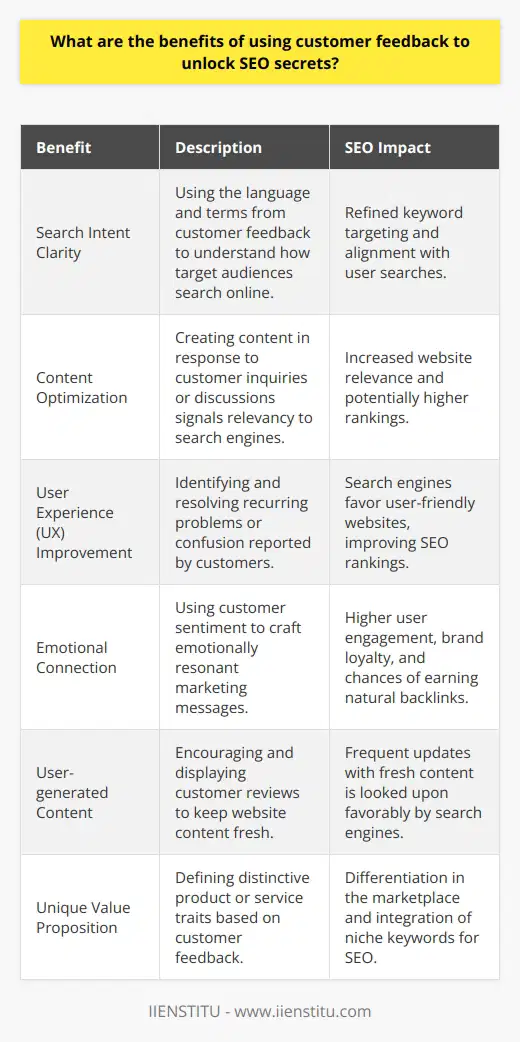
How can customer feedback help to improve a website's search engine optimization?
Search engine optimization (SEO) is integral to website design and management. It helps to ensure that the website is visible to potential customers and that they can find the information they are looking for quickly and easily. One of how a website's SEO can be improved is through customer feedback.
Customer feedback is a valuable source of information that can help website owners to identify areas where their website is falling short. This could include navigation, content relevance, performance, or usability issues. Taking the time to listen to customer comments and address the areas of concern can help to ensure that the website is more visible and better optimized for search engines.
Customer feedback can also provide website owners insight into what customers want. This can help inform the content created and ensure that the website is relevant and up to date. Customers may also be able to provide suggestions for improvements that could be made to the website, such as changes to navigation, layout, or functionality.
Finally, customer feedback can help website owners better understand their customer base and the needs of their target audience. This can help to ensure that the website content is tailored to meet the needs of the customer and that the website is optimized for the types of searches that customers are likely to use.
In summary, customer feedback can be a valuable source of information for website owners looking to improve their website's search engine optimization. Taking the time to listen to customer comments and address areas of concern can help to ensure that the website is more visible and better optimized for search engines. Additionally, customer feedback can help inform the website content and ensure that it is tailored to meet the customer's needs.
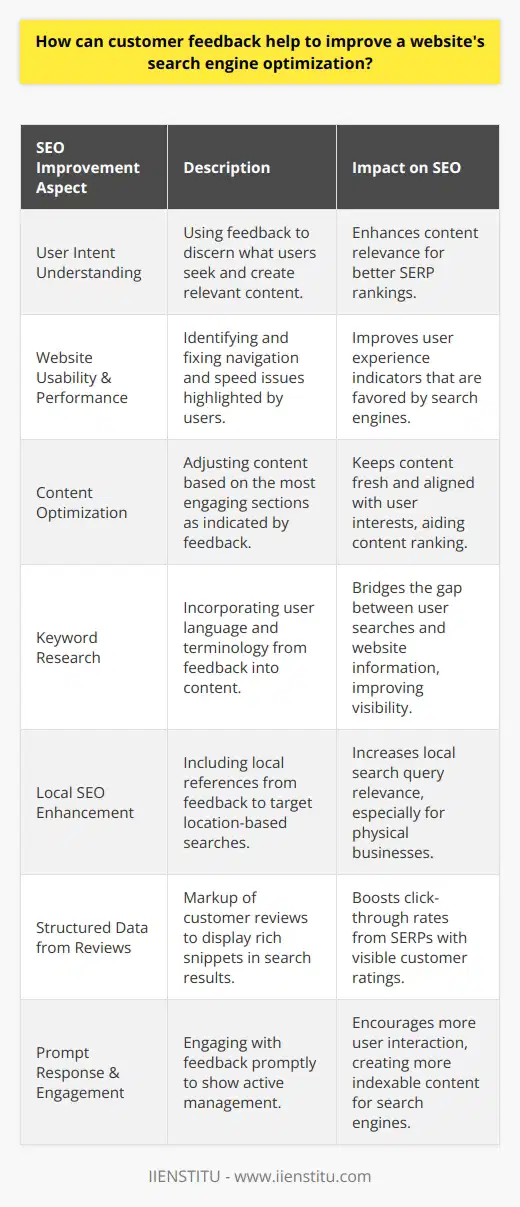
What strategies can be used to effectively gather customer feedback for SEO purposes?
In the ever-evolving digital landscape, businesses need to understand their customer’s needs and preferences to remain competitive. In particular, search engine optimization (SEO) is critical in driving website traffic and increasing brand visibility. Collecting customer feedback is crucial in optimizing an organization’s SEO strategy. The following outlines strategies that can be used to gather customer feedback for SEO purposes effectively.
First, businesses should take advantage of online surveys to collect customer feedback. Surveys allow businesses-companies to ask customers detailed questions about their experiences with the organization’s products and services. As a result, businesses can gain valuable insights into customer preferences and identify areas for improvement. For example, a survey may ask customers for feedback on product descriptions or website navigation.
Second, businesses should utilize customer reviews to gain insight into customer satisfaction. Reviews are a powerful tool for learning about customer experiences with a business’s products and services. In addition, reviews provide valuable insight into customer expectations and preferences, which can be used to improve SEO. For example, reviews can identify keywords and phrases that customers use to describe the business’s products and services.
Third, businesses should use social media to connect with customers and gain feedback. Social media allows businesses to engage with customers and understand their preferences. By engaging with customers on social media, companies can learn about the types of content customers are interested in and use this information to optimize their SEO strategy. For example, companies can use insights from social media to optimize titles, descriptions, and other elements of their website content.
Finally, businesses should leverage analytics tools to track customer behavior. Analytics tools provide companies with detailed insights into customer behavior on their website. This includes information such as the types of searches customers use to find the website, the pages they visit, and the amount of time they spend on each page. This data can be used to identify areas for improvement and optimize an organization’s SEO strategy.
In conclusion, effectively gathering customer feedback is critical in optimizing an organization’s SEO strategy. By taking advantage of online surveys, customer reviews, social media, and analytics tools, businesses can gain valuable insights into customer preferences and use this information to improve their SEO.
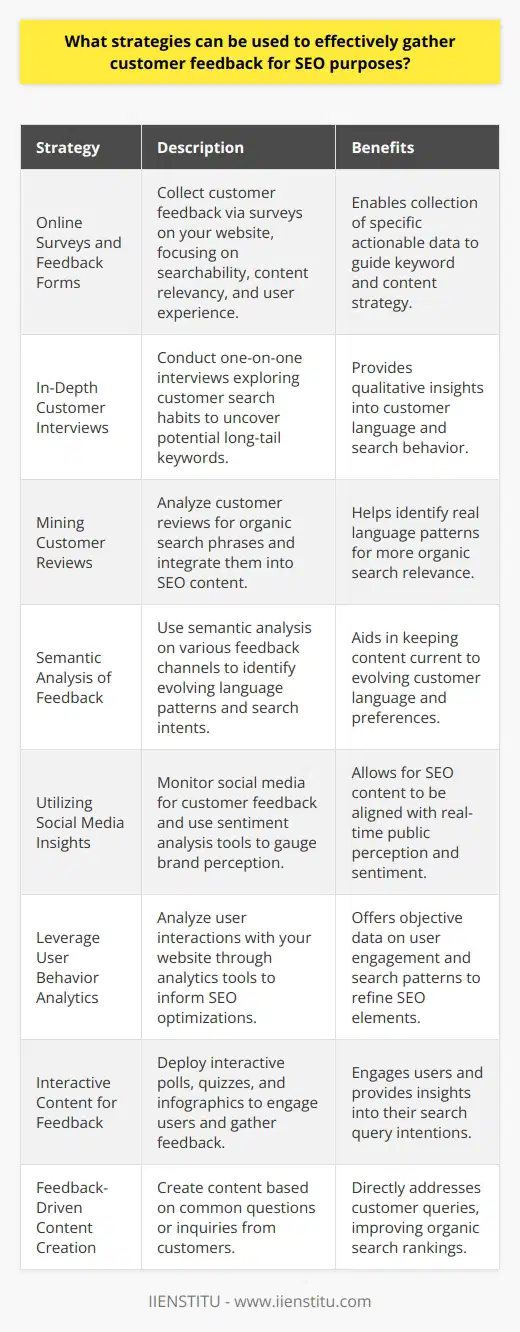
What are the primary components of an effective SEO strategy in 2023?
Keyword Research and Optimization
The first critical component of an effective SEO strategy in 2023 is keyword research and optimization. Web developers should use tools like Google Keyword Planner to find the most relevant keywords for their content.
High-Quality Content
High-quality content is also of utmost importance. This involves creating original and exciting content that provides true value to the reader. Search engines prioritize high-quality content in their rankings, providing better visibility to such websites.
Mobile Optimization
With the ever-increasing usage of mobile devices, mobile optimization of web content has become essential. Websites that display correctly on various mobile devices have a better chance of ranking higher in search engine results.
Website Speed
A slow loading website will likely deter users, leading to a high bounce rate. Search engines monitor these rates, and thus improving website speed is a crucial aspect of SEO.
Secure Website
Websites also need to be secure. Search engines favor HTTPS websites. It assures users their information is safe, which can lead to a higher user interaction rate.
Inbound and Outbound Links
Both inbound and outbound linking strategies can aid SEO. These links inform search engines about the influence and value of your site’s content, thereby improving ranking.
Regular Updates
Staying current is also important. Regular updates are beneficial for SEO as out-of-date websites tend not to rank as highly.
Social Media Integration
Lastly, integrating your website with social media platforms can significantly boost your online presence. By enabling easy sharing options, you can optimize your site’s visibility across different platforms.
In conclusion, effective SEO in 2023 will require a well-rounded approach incorporating keywords, quality content, mobile optimization, speed, security, links, updates, and social media integration. By mastering these aspects, a website can significantly improve its search engine rankings.
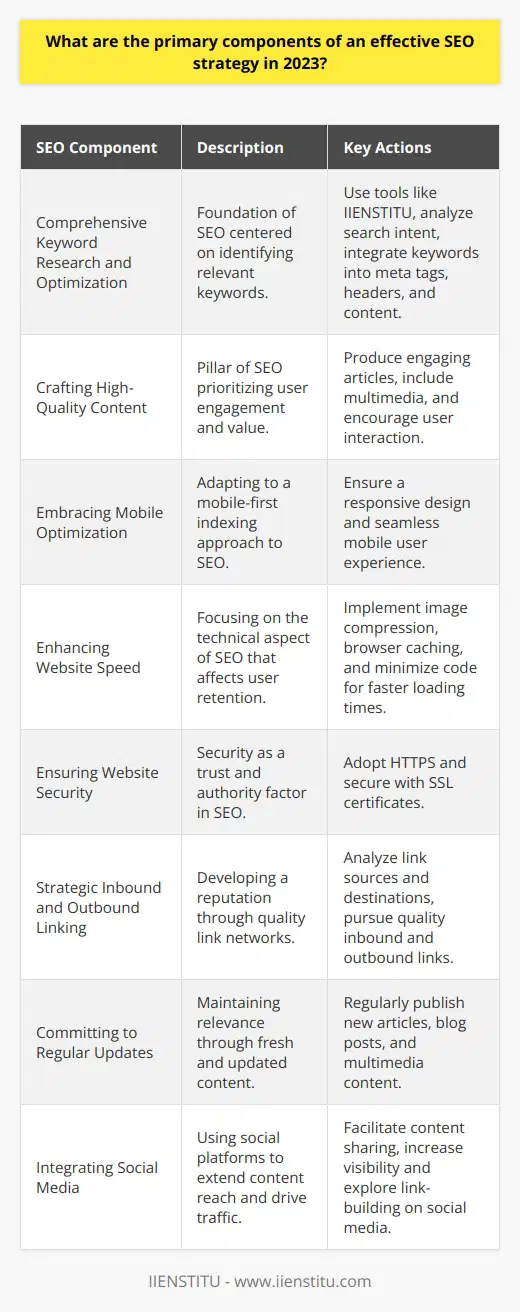
How can businesses efficiently implement the top SEO tactics to enhance their online visibility and conversion rates?
Adopting a Clear SEO Approach
Businesses can efficiently implement top SEO tactics by first adopting a clear, strategic SEO approach. Basic yet vital SEO strategies such as keyword optimization and high-quality content creation can greatly enhance online visibility.
Keyword Optimization
Optimal keyword use can boost website rankings. Businesses should conduct thorough keyword research that aligns with their products, services, and target audience needs. Incorporating these keywords into website content, meta tags, and URLs can improve search engine visibility.
High-quality Content Creation
Content is king in SEO. Businesses need high-quality, relevant, and engaging content that targets potential customers. Blogs, articles, and web pages should offer value, address user queries and incorporate optimized keywords naturally.
Link Building Strategy
Link building remains crucial in SEO. Acquiring backlinks from reputable and relevant domains can significantly boost a website’s authority in search engine algorithms. Including both inbound and outbound links in the content also improves its relevance and authenticity.
Website Optimization
At a technical level, businesses should ensure their websites are mobile-friendly, quick to load, and easily navigable. A well-optimized site aids user experience, reducing bounce rates, and improving conversion rates.
Metrics Evaluation and Adjustment
Implementing SEO tactics is not a one-off task. Businesses ought to monitor performance metrics regularly, assessing the effectiveness of their SEO strategy. Changes in search engine algorithms, web traffic, and consumer behavior may necessitate SEO adjustments over time.
In conclusion, adopting these top SEO tactics and continuously evaluating their effectiveness can significantly enhance a business's online visibility and conversion rates.
(SEO - Search Engine Optimization)
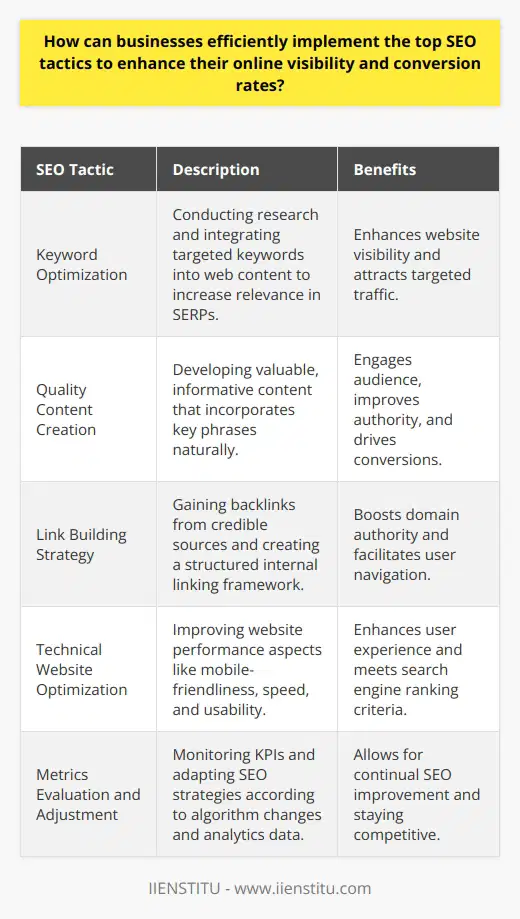
Are there any specific review management techniques that can directly contribute to improved SEO performance?
Review Management Techniques and SEO Performance
Strong review management can indeed enhance SEO performance. Google algorithms consider numerous factors, and reviews play an essential role in local SEO.
Positive Impact of Reviews
User-generated content such as reviews can boost SEO. Reviews generate fresh, unique content which Google values. Increased online reviews can result in higher visibility in search engine results pages (SERPs).
Reviews Increase Keywords
Reviews naturally incorporate keywords. Users often describe the service or product in their reviews, thus adding relevant keywords to your content. This organically improves your keyword density and SEO without keyword stuffing.
Improved Click-through Rates (CTR)
Good reviews improve click-through rates. A positive star rating can increase trust and attract more users to click on your webpage. Increased traffic is a positive signal for search engines, thus improving SEO rank.
Importance of Responding to Reviews
Responding to reviews matters as well. Google acknowledges businesses that interact with their customers. Timely, professional responses to reviews can contribute to improved SEO performance.
Concluding Remarks
In summary, review management techniques play a crucial role in SEO performance. They improve visibility, keyword density, click-through rates, and user interaction. Businesses should prioritize review management to bolster their SEO strategy.
